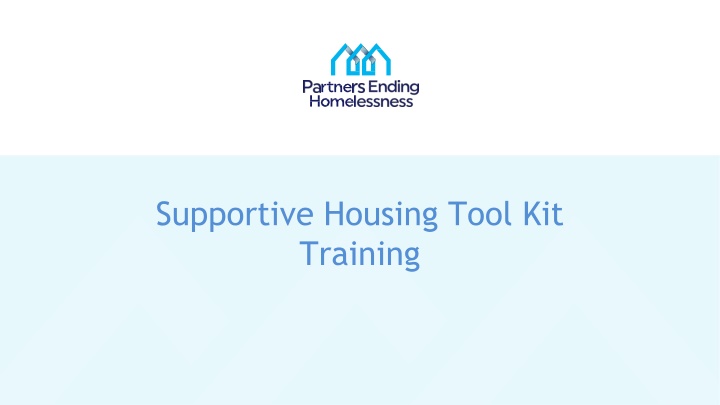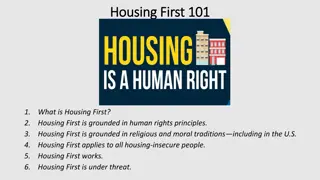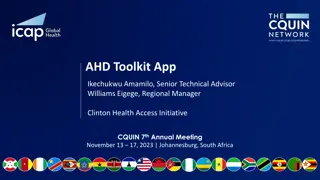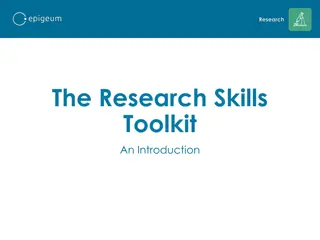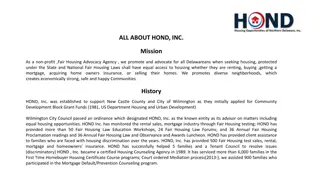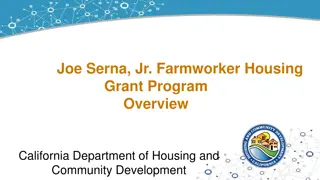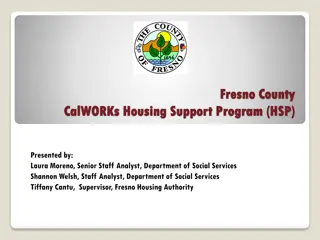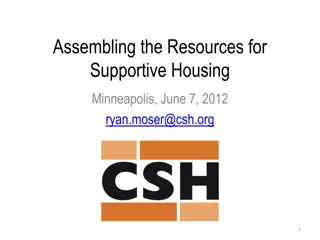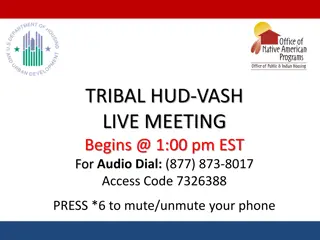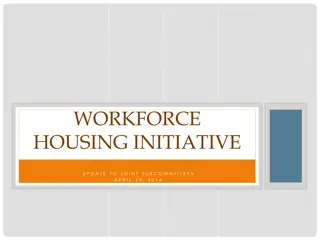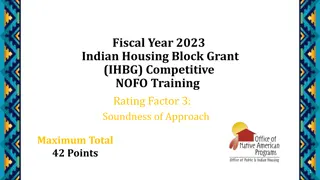Supportive Housing Toolkit Training and Community Collaboration
Explore a comprehensive training program on supportive housing toolkit, emphasizing community collaboration and assessment tools to address homelessness effectively. The toolkit covers various aspects such as value, community needs, introduction to tools, and initiatives for 2022 and beyond. Enhance your understanding of the supportive housing landscape and the importance of strategic resource allocation for sustainable impact.
Download Presentation

Please find below an Image/Link to download the presentation.
The content on the website is provided AS IS for your information and personal use only. It may not be sold, licensed, or shared on other websites without obtaining consent from the author.If you encounter any issues during the download, it is possible that the publisher has removed the file from their server.
You are allowed to download the files provided on this website for personal or commercial use, subject to the condition that they are used lawfully. All files are the property of their respective owners.
The content on the website is provided AS IS for your information and personal use only. It may not be sold, licensed, or shared on other websites without obtaining consent from the author.
E N D
Presentation Transcript
Supportive Housing Tool Kit Training
Introductions Janice Steimer Partner Ending Homelessness Donna Catalano -Volunteers of America HMIS Coordinator Alex Storms YWCA Charles Bollinger III Partner Ending Homelessness Trisha Lucas Delphi Rise COC Programs Coordinator Kristin Clarke Providence Housing letsendhomelessness.org
Agenda The Value for the Tool Community need for the Tool Introduction to the Tool Policy and Procedures Assessment in HMIS Acuity Index Projects feedback What to expect in 2022 and Beyond letsendhomelessness.org
Value of the Tool The development of this Assessment was a community effort. Several Permanent Housing Programs helped. This Assessment has been tested in projects since October of 2019. Which includes a paper version and HMIS version letsendhomelessness.org
Community need for the Tool HUD NOFA 2019 (II. A. 3. Pages 5 & 6 of 81) Strategically allocating and using resources. Using cost, performance, and outcome data, CoCs should improve how resources are utilized to end homelessness. CoCs should review project quality, performance, and cost effectiveness. HUD also encourages CoCs to maximize the use of mainstream and other community-based resources when serving 6 of 81 persons experiencing homelessness. CoCs should also work to develop partnerships to help CoC Program participants sustainably exit permanent supportive housing, such as through partnerships with Public Housing Authorities (PHAs) and other government, faith-based, and nonprofit resources specializing in areas such as treating mental illness, treating substance abuse, job training, life skills, or similar activities, including those that help CoC Program participants, whenever possible, reach recovery, self-sufficiency, and independence. Finally, CoCs should review all projects eligible for renewal in FY 2019 to determine their effectiveness in serving people experiencing homelessness, including cost effectiveness. letsendhomelessness.org
Introduction to the Tool There are Two (2) parts to the tool The Assessment in HMIS The Acuity index found on the website letsendhomelessness.org
Introduction to the Tool The Supportive Housing Assessment Tool (with Acuity Index) is designed to be completed in collaboration with the Head of Household and the case manager. It should be completed across multiple meetings at intake and annually to determine the client or family s level of need and to assist in developing services plan goals. This assessment should be used as a voluntary tool and cannot be used to remove a client or family from Permanent Housing (PSH or RRH). letsendhomelessness.org
Introduction to the Tool What is the Supportive Housing Tool Kit? The Supportive Housing tool kit was largely adopted from a tool kit developed by the Corporation for Supportive Housing (CSH). Although there may be some slight differences in the CHS tool kit and our local tool kit the overarching goals, principals, and components are the same. An important piece of the tool kit is an assessment that is to be completed with Permanent Housing (PSH-RRH) participants, ongoing, to assist them in achieving the highest levels of independence. By designing an assessment to be used by all PSH programs in the community we are creating more consistency in the way we identify and assist individual needs. Full instructions on how and when to complete the assessment will be provided in a separate document letsendhomelessness.org
Introduction to the Tool Why have a Supportive Housing Assessment? A key component to the tool kit is to promote tenant success and mobility, empowering individuals to reach their full potential and achieve the highest level of self-sufficiency possible for that person. In addition, such a process increases the capacity of homeless systems to ensure that supportive housing is used to serve the most vulnerable individuals and families. letsendhomelessness.org
Acuity Index Scoring Screening and Assessment: Emotional independence (interest and confidence in moving on) Financial Capacity (employment, income, savings, budgeting skills) Housing history (housing tenure, rent arrears, past evictions, neighbor/landlord relationships) Intensity of service use (need for on-site services) Health/behavioral health (substance use, mental health, medication management, treatment engagement, mobility) Connection to mainstream resources (rental supports if needed) Connection to family or other natural supports Community living skills (self-managing behavior; limit setting relating to drugs, etc.) Activities of daily living skills (ability to get meals; keep apartment clean; follow lease) Housing goals (location, size, affordability, live with family/friends) letsendhomelessness.org
Acuity Index usefulness Key Principles: Voluntary; participants are never required to exit PSH if they do not wish to do so Maximizing housing options Promoting economic mobility and self-sufficiency Key Service Components: Case Notes Independent Living-Skills training Wellness/Illness Self-Management Community Based Services Employment Supports Peer Supports letsendhomelessness.org
When should the tools be completed and updated? Complete the Assessment Tool after intake Acuity Index can be done at anytime time during the client's first year in project. However, the second Acuity index must be completed at the time of annual renewal letsendhomelessness.org
Acuity index Acuity Index for PSH Acuity Index for RRH Both can be found on PEH website After completion of Acuity Index, save and upload to HMIS and label it at the date completed. letsendhomelessness.org
Acuity index Upload Acuity Index to HMIS Save and upload to HMIS and label it at the date completed. Please refer to handout labeled: Supportive Housing Assessment and Acuity Index Upload into HMIS letsendhomelessness.org
Assessment in HMIS All Assessments are to be completed in HMIS letsendhomelessness.org
Policy and Procedures Using the answers from the Supportive Housing Assessment Tool & Acuity Index, discuss with the client (and collaterals) areas where they would like to increase their self-sufficiency When completing the Assessment Tool & Acuity Index at intake/annually, it will useful to have following available to accurately assess where the client is and where they would like to be in the next year: It is critical to note that when programs are reviewed, reviewers will look to see that this Assessment guides Service Plan development and case/progress notes provide detailed information related to achieving Service Plan goals. letsendhomelessness.org
Project Feedback Delphi Rise Providence RHA/YWCA Case Management VOA letsendhomelessness.org
Moving Forward Developing a Move on toolkit (in 2023) Monitoring Assessments and Acuity Index s (in 2022) Tracking outcomes from Supportive Housing Assessments Feedback and update of Supportive Housing Assessment (2023) letsendhomelessness.org
Questions letsendhomelessness.org
